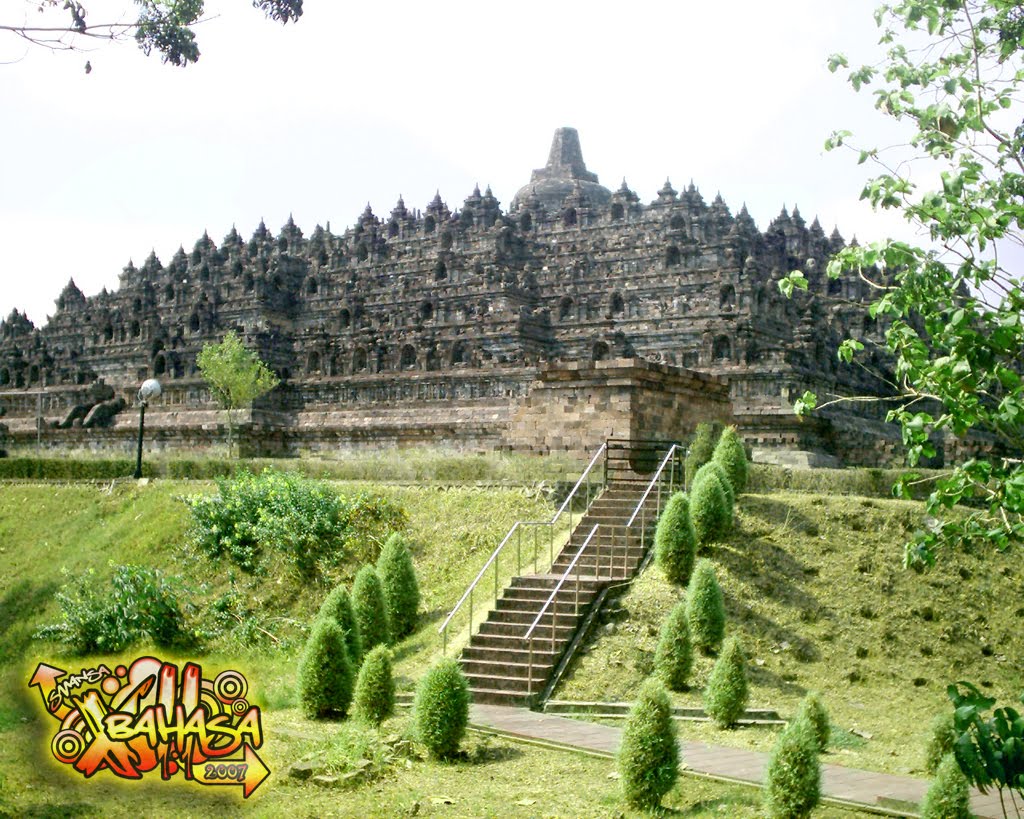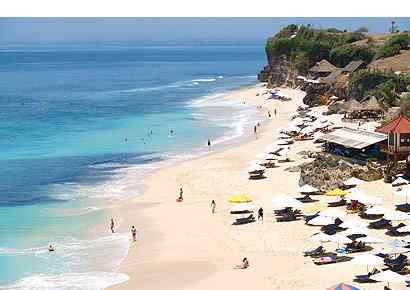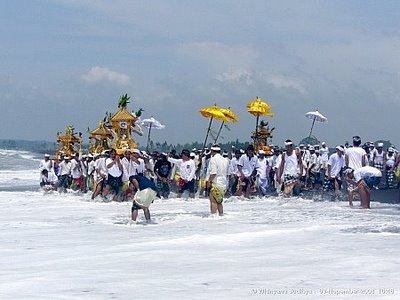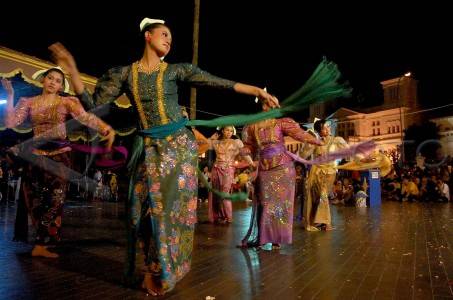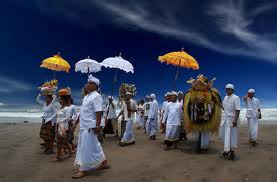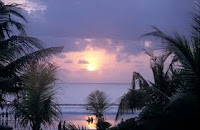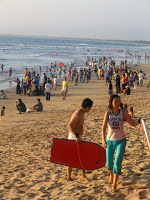Jaipongan is a genre of dance that was born from the creativity of an artist from Bandung, Gugum Gumbira. Attention to folk art, one of which is Tap Tilu know and know well make it perbendaharan dance movement patterns that exist in the tradition Kliningan / Bajidoran or Tap Tilu. Opening movements, pencugan, nibakeun and several kinds of motion of several arts mincid above have enough inspiration to develop a dance or art that is now known as the Jaipongan.

Before this form of performance art show, there are several forms of dance influences behind this association. In West Java, for example, social dance is the influence of the Ball Room, which is usually in a dance-dance association could not be separated from existence and pamogoran ronggeng. Ronggeng in social dance is no longer functioning for activities of the ceremony, but for entertainment or a way of hanging out. The existence ronggeng in the performing arts has an appeal that invites sympathy for the pamogoran. For example on Tilu Tap dance is so well known by the Sundanese people, is expected this art popular around the year 1916. As the folk performing arts, this art is supported only by simple elements, such as waditra that includes fiddle, drums, two kulanter, three percussion, and gongs. Similarly, the dance movements that do not have a standard pattern of motion, a simple costume dancer as a reflection of democracy.

Along with the waning type of art above, the former pamogoran (spectators who play an active role in the performing arts Tap Tilu / Doger / Tayub) switched its attention on the performing arts Kliningan, which in the north coast of West Java (Karawang, Bekasi, Purwakarta, Indramayu, and Subang ) known as Kliningan Bajidoran dance patterns and events that show has some similarities with the previous art (Tap Tilu / Doger / Tayub). In the meantime, the existence of masked dances in Banjet quite popular, especially in Karachi, where some Bajidoran motion pattern taken from the dance in this Banjet Mask. In koreografis dance is still reveal the patterns of tradition (Tap Tilu) which contains elements of the opening movements, pencugan, nibakeun and several kinds of motion mincid which in turn become the basis of the creation of dance Jaipongan. Some basic dance movements Jaipongan apart from Tap Tilu, Ibing Bajidor and Mask Banjet is Tayuban and Pencak Silat.

The emergence of dance works Gugum Gumbira initially called Tap Tilu development, that is because it is a basic dance from Tap Tilu development. The first work Gugum Gumbira still very thick with color Ibing Tilu Tap, both in terms of choreography and iringannya, who then dance it became popularly known as Jaipongan. Work Jaipongan first began to be known by the public is dance "Leaves Pulus Keser Bojong" and "Rendeng Bojong" both of which are types of dance girls and dance in pairs (boys and girls). From the dance that emerged a few names that are reliable Jaipongan dancers like Tati Saleh, Yeti Mamat, Eli Somali, and Pepen Dedi Kurniadi. Early emergence of the dance had become a conversation, the central issue is the movement of the erotic and vulgar. But from the few print media exposure, name Gugum Gumbira becoming known society, especially after the dance Jaipongan in 1980 staged at the central station TVRI Jakarta. The impact of the popularity of the more increases the frequency of performances, both in the medium of television, a celebration or celebrations held by the private sector and government.

Attendance Jaipongan significant contribution towards the instigators of the art of dance to more actively explore the types of folk dances that were previously less attention. With the emergence of dance Jaipongan, used by activists to organize dance courses dance Jaipongan, used also by businessmen pubs as a decoy night invited guests, where the further development of this kind of business opportunities created by the instigators of dance as an economic empowerment efforts by Dance Studio names or groups in some areas of West Java, for example in Subang with Jaipongan style "kaleran" (north). Typical Jaipongan kaleran style, which is fun, erotic, humorous, excitement, spontaneity, and simplicity (naturally, whatever they are). This was reflected in the pattern of presentation of dance on the show, there is a given pattern (Ibing pattern) as in art Jaipongan in Bandung, also there are also dances that are not dipola (Ibing Saka), for example in art Jaipongan Subang and Karawang. This term can be found in Jaipongan kaleran style, especially in the area of Subang. In the presentation, this kaleran Jaipongan style, as follows: 1) Tatalu; 2) Flower Gadung; 3) Fruit Kawung Gopar; 4) Dance Opening (Ibing Pattern), usually performed by a single dancer or Sinden Tatandakan (sinden attack but can not sing but dance songs sinden / interpreter kawih); 5) Jeblokan and Jabanan, is part performance when the audience (Bajidor) Sawer money (jabanan) while greeting paste. Jeblokan term is defined as couples who settled between sinden and the audience (Bajidor).

Further development occurred in taahun dance Jaipongan 1980-1990's, where Gugum Gumbira create another dance such as Toka-toka, Setra Sari, Sonteng, Pencug, Heron dazed, motorcade procession Leaf-Puring, Rawayan, and Dance Kawung Anten. From these dances appear some skilled dancers Jaipongan include Iceu Effendi, Yumiati Mandiri, Miming Mintarsih, Nani, Erna, Mira Tejaningrum, Ine Dinar, Ega, Nuni, Cepy, Agah, Aa Suryabrata, and Asep. Today the dance Jaipongan be called as one of identity keseniaan West Java, this is apparent on several important events relating to visitors from foreign countries who came to West Java, it was greeted with Jaipongan dance performances. Similarly, with art missions to foreign countries, always equipped with a dance Jaipongan. Dance Jaipongan affect many other crafts in the community of West Java, both on the art of wayang, gamelan, Genjring / Terbangan, Kacapi jaipong, and almost all public performances as well as on modern dangdut music which collaborated with the art Jaipong Pong-Dut. Jaipongan which has diplopori by Mr. Nur & Leni
 Before this form of performance art show, there are several forms of dance influences behind this association. In West Java, for example, social dance is the influence of the Ball Room, which is usually in a dance-dance association could not be separated from existence and pamogoran ronggeng. Ronggeng in social dance is no longer functioning for activities of the ceremony, but for entertainment or a way of hanging out. The existence ronggeng in the performing arts has an appeal that invites sympathy for the pamogoran. For example on Tilu Tap dance is so well known by the Sundanese people, is expected this art popular around the year 1916. As the folk performing arts, this art is supported only by simple elements, such as waditra that includes fiddle, drums, two kulanter, three percussion, and gongs. Similarly, the dance movements that do not have a standard pattern of motion, a simple costume dancer as a reflection of democracy.
Before this form of performance art show, there are several forms of dance influences behind this association. In West Java, for example, social dance is the influence of the Ball Room, which is usually in a dance-dance association could not be separated from existence and pamogoran ronggeng. Ronggeng in social dance is no longer functioning for activities of the ceremony, but for entertainment or a way of hanging out. The existence ronggeng in the performing arts has an appeal that invites sympathy for the pamogoran. For example on Tilu Tap dance is so well known by the Sundanese people, is expected this art popular around the year 1916. As the folk performing arts, this art is supported only by simple elements, such as waditra that includes fiddle, drums, two kulanter, three percussion, and gongs. Similarly, the dance movements that do not have a standard pattern of motion, a simple costume dancer as a reflection of democracy. Along with the waning type of art above, the former pamogoran (spectators who play an active role in the performing arts Tap Tilu / Doger / Tayub) switched its attention on the performing arts Kliningan, which in the north coast of West Java (Karawang, Bekasi, Purwakarta, Indramayu, and Subang ) known as Kliningan Bajidoran dance patterns and events that show has some similarities with the previous art (Tap Tilu / Doger / Tayub). In the meantime, the existence of masked dances in Banjet quite popular, especially in Karachi, where some Bajidoran motion pattern taken from the dance in this Banjet Mask. In koreografis dance is still reveal the patterns of tradition (Tap Tilu) which contains elements of the opening movements, pencugan, nibakeun and several kinds of motion mincid which in turn become the basis of the creation of dance Jaipongan. Some basic dance movements Jaipongan apart from Tap Tilu, Ibing Bajidor and Mask Banjet is Tayuban and Pencak Silat.
Along with the waning type of art above, the former pamogoran (spectators who play an active role in the performing arts Tap Tilu / Doger / Tayub) switched its attention on the performing arts Kliningan, which in the north coast of West Java (Karawang, Bekasi, Purwakarta, Indramayu, and Subang ) known as Kliningan Bajidoran dance patterns and events that show has some similarities with the previous art (Tap Tilu / Doger / Tayub). In the meantime, the existence of masked dances in Banjet quite popular, especially in Karachi, where some Bajidoran motion pattern taken from the dance in this Banjet Mask. In koreografis dance is still reveal the patterns of tradition (Tap Tilu) which contains elements of the opening movements, pencugan, nibakeun and several kinds of motion mincid which in turn become the basis of the creation of dance Jaipongan. Some basic dance movements Jaipongan apart from Tap Tilu, Ibing Bajidor and Mask Banjet is Tayuban and Pencak Silat. The emergence of dance works Gugum Gumbira initially called Tap Tilu development, that is because it is a basic dance from Tap Tilu development. The first work Gugum Gumbira still very thick with color Ibing Tilu Tap, both in terms of choreography and iringannya, who then dance it became popularly known as Jaipongan. Work Jaipongan first began to be known by the public is dance "Leaves Pulus Keser Bojong" and "Rendeng Bojong" both of which are types of dance girls and dance in pairs (boys and girls). From the dance that emerged a few names that are reliable Jaipongan dancers like Tati Saleh, Yeti Mamat, Eli Somali, and Pepen Dedi Kurniadi. Early emergence of the dance had become a conversation, the central issue is the movement of the erotic and vulgar. But from the few print media exposure, name Gugum Gumbira becoming known society, especially after the dance Jaipongan in 1980 staged at the central station TVRI Jakarta. The impact of the popularity of the more increases the frequency of performances, both in the medium of television, a celebration or celebrations held by the private sector and government.
The emergence of dance works Gugum Gumbira initially called Tap Tilu development, that is because it is a basic dance from Tap Tilu development. The first work Gugum Gumbira still very thick with color Ibing Tilu Tap, both in terms of choreography and iringannya, who then dance it became popularly known as Jaipongan. Work Jaipongan first began to be known by the public is dance "Leaves Pulus Keser Bojong" and "Rendeng Bojong" both of which are types of dance girls and dance in pairs (boys and girls). From the dance that emerged a few names that are reliable Jaipongan dancers like Tati Saleh, Yeti Mamat, Eli Somali, and Pepen Dedi Kurniadi. Early emergence of the dance had become a conversation, the central issue is the movement of the erotic and vulgar. But from the few print media exposure, name Gugum Gumbira becoming known society, especially after the dance Jaipongan in 1980 staged at the central station TVRI Jakarta. The impact of the popularity of the more increases the frequency of performances, both in the medium of television, a celebration or celebrations held by the private sector and government. Attendance Jaipongan significant contribution towards the instigators of the art of dance to more actively explore the types of folk dances that were previously less attention. With the emergence of dance Jaipongan, used by activists to organize dance courses dance Jaipongan, used also by businessmen pubs as a decoy night invited guests, where the further development of this kind of business opportunities created by the instigators of dance as an economic empowerment efforts by Dance Studio names or groups in some areas of West Java, for example in Subang with Jaipongan style "kaleran" (north). Typical Jaipongan kaleran style, which is fun, erotic, humorous, excitement, spontaneity, and simplicity (naturally, whatever they are). This was reflected in the pattern of presentation of dance on the show, there is a given pattern (Ibing pattern) as in art Jaipongan in Bandung, also there are also dances that are not dipola (Ibing Saka), for example in art Jaipongan Subang and Karawang. This term can be found in Jaipongan kaleran style, especially in the area of Subang. In the presentation, this kaleran Jaipongan style, as follows: 1) Tatalu; 2) Flower Gadung; 3) Fruit Kawung Gopar; 4) Dance Opening (Ibing Pattern), usually performed by a single dancer or Sinden Tatandakan (sinden attack but can not sing but dance songs sinden / interpreter kawih); 5) Jeblokan and Jabanan, is part performance when the audience (Bajidor) Sawer money (jabanan) while greeting paste. Jeblokan term is defined as couples who settled between sinden and the audience (Bajidor).
Attendance Jaipongan significant contribution towards the instigators of the art of dance to more actively explore the types of folk dances that were previously less attention. With the emergence of dance Jaipongan, used by activists to organize dance courses dance Jaipongan, used also by businessmen pubs as a decoy night invited guests, where the further development of this kind of business opportunities created by the instigators of dance as an economic empowerment efforts by Dance Studio names or groups in some areas of West Java, for example in Subang with Jaipongan style "kaleran" (north). Typical Jaipongan kaleran style, which is fun, erotic, humorous, excitement, spontaneity, and simplicity (naturally, whatever they are). This was reflected in the pattern of presentation of dance on the show, there is a given pattern (Ibing pattern) as in art Jaipongan in Bandung, also there are also dances that are not dipola (Ibing Saka), for example in art Jaipongan Subang and Karawang. This term can be found in Jaipongan kaleran style, especially in the area of Subang. In the presentation, this kaleran Jaipongan style, as follows: 1) Tatalu; 2) Flower Gadung; 3) Fruit Kawung Gopar; 4) Dance Opening (Ibing Pattern), usually performed by a single dancer or Sinden Tatandakan (sinden attack but can not sing but dance songs sinden / interpreter kawih); 5) Jeblokan and Jabanan, is part performance when the audience (Bajidor) Sawer money (jabanan) while greeting paste. Jeblokan term is defined as couples who settled between sinden and the audience (Bajidor). Further development occurred in taahun dance Jaipongan 1980-1990's, where Gugum Gumbira create another dance such as Toka-toka, Setra Sari, Sonteng, Pencug, Heron dazed, motorcade procession Leaf-Puring, Rawayan, and Dance Kawung Anten. From these dances appear some skilled dancers Jaipongan include Iceu Effendi, Yumiati Mandiri, Miming Mintarsih, Nani, Erna, Mira Tejaningrum, Ine Dinar, Ega, Nuni, Cepy, Agah, Aa Suryabrata, and Asep. Today the dance Jaipongan be called as one of identity keseniaan West Java, this is apparent on several important events relating to visitors from foreign countries who came to West Java, it was greeted with Jaipongan dance performances. Similarly, with art missions to foreign countries, always equipped with a dance Jaipongan. Dance Jaipongan affect many other crafts in the community of West Java, both on the art of wayang, gamelan, Genjring / Terbangan, Kacapi jaipong, and almost all public performances as well as on modern dangdut music which collaborated with the art Jaipong Pong-Dut. Jaipongan which has diplopori by Mr. Nur & Leni
Further development occurred in taahun dance Jaipongan 1980-1990's, where Gugum Gumbira create another dance such as Toka-toka, Setra Sari, Sonteng, Pencug, Heron dazed, motorcade procession Leaf-Puring, Rawayan, and Dance Kawung Anten. From these dances appear some skilled dancers Jaipongan include Iceu Effendi, Yumiati Mandiri, Miming Mintarsih, Nani, Erna, Mira Tejaningrum, Ine Dinar, Ega, Nuni, Cepy, Agah, Aa Suryabrata, and Asep. Today the dance Jaipongan be called as one of identity keseniaan West Java, this is apparent on several important events relating to visitors from foreign countries who came to West Java, it was greeted with Jaipongan dance performances. Similarly, with art missions to foreign countries, always equipped with a dance Jaipongan. Dance Jaipongan affect many other crafts in the community of West Java, both on the art of wayang, gamelan, Genjring / Terbangan, Kacapi jaipong, and almost all public performances as well as on modern dangdut music which collaborated with the art Jaipong Pong-Dut. Jaipongan which has diplopori by Mr. Nur & Leni

